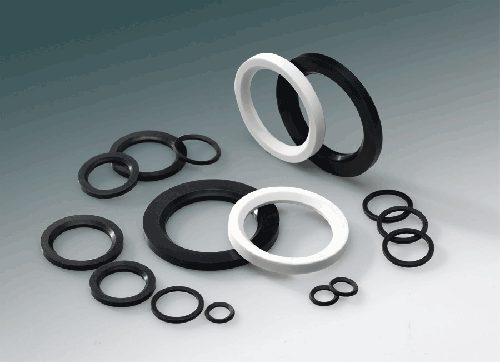PTFE MoS2 filled Ball seal

•100% Virgin PTFE
•10% fiber glass filled PTFE
•15% Peek filled PTFE
•15 To 25% Glass Filled PTFE
•25 To 35% Carbon Filled PTFE
•15% Graphite Filled PTFE
•40 to 60% Bronzed Filled PTFE
•5 to 15% Aluminium Oxide Filled PTFE
•5 to 10% Stainless Steel Filled PTFE
we can add the above filled material into PTFE to improve its:
Mechanical properties
Fillers increase the hardness of PTFE and reduce cold flow or creep. Tensile strength and elongation usually are reduced depending on the filler type and percentage.
Thermal properties
Filler increase thermal conductivity. Fillers also reduce liner coefficient of thermal expansion then increase thermal dimensional stability.
Electrical properties
Some filler increase electrical conductivity.
Tribological properties
Fillers reduce wear rate and friction.
Types of fillers
●Glassfiber-the most common filler
* Reduces creep
* Chemically stable (except to strong alkalis and hydrofluoric acid)
* Performs well in oxidizing environments
* Improves the wear characteristics of PTFE
●EG Carbon
* Reduces creep
* Increases hardness
* Raises thermal conductivity
* Improves wear rate
* Electrical conductivity - antistatic
* Lowers tool wear during machining
●Carbon powder
* Reduces creep
* Increases hardness
* Raises thermal conductivity
* Electrical conductivity-antistatic
* Improves lubricity
●Carbon fiber
* Reduces creep
* Increases flex and compressive modulus
* Increase hardness
* Inert to HF and strong alkalis
* Less carbon fiber needed than glass fiber to achieve the same effects
* Raises thermal conductivity
* Increases wear resistance
●Graphite
*Extremely low coefficient of friction
*Chemically inert
*Usually incorporated with other fillers such as glass or carbon
*Increases wear resistance especially against soft metal
●Metallic fillers
*Bronze is the most common metallic filler, the other choice is stainless steel
*Reduces deformation under load
*Raises thermal and electrical conductivity
●Molybdenum disulfide
*Increase hardness
*Reduces friction
*Usually combined with other fillers such as glass or bronze
●Crystalline polymer
*Increases wear resistance especially against soft metal
*Decreases coefficient of thermal expansion
*Raises PV limit due to adhesive wear transfer mechanism
*Lowers friction coefficient
*FDA compliant
| 
